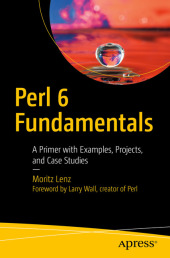 Neuerscheinungen 2017Stand: 2020-02-01 |
Schnellsuche
ISBN/Stichwort/Autor
|
Herderstra▀e 10
10625 Berlin
Tel.: 030 315 714 16
Fax 030 315 714 14
info@buchspektrum.de |

Moritz Lenz
Perl 6 Fundamentals
A Primer with Examples, Projects, and Case Studies
1st ed. 2017. xix, 142 S. 3 SW-Abb., 12 Farbabb. 235 mm
Verlag/Jahr: SPRINGER, BERLIN; APRESS 2017
ISBN: 1-484-22898-7 (1484228987)
Neue ISBN: 978-1-484-22898-2 (9781484228982)
Preis und Lieferzeit: Bitte klicken
Gain the skills to begin developing Perl 6 applications from the ground up in this hands-on compact book, which includes a foreword from Larry Wall, creator of Perl. You┤ll learn enough to get started building with Perl 6, using Perl 6┤s gradual typing, handy object orientation features, powerful parsing capabilities, and human-usable concurrency. After a short introduction, each chapter develops a small example project, explaining the Perl 6 features used. When the example is done, you┤ll explore another aspect, such as optimizing further for readability or testing the code.
Along the way you┤ll see Perl 6 basics, such as variables and scoping; subroutines; classes and objects; regexes; and code testing. When you┤ve mastered the basics, Perl 6 Fundamentals moves onto more advanced topics to give you a deeper understanding of the language. You┤ll learn, amongst other things, how to work with persistent storage, how to generate good error messages, and how to write tricky applications such as a file and directory usage graph and a Unicode search tool.
What You┤ll Learn
Get coding with Perl 6
Work on several hands-on examples and projects
Integrate Python libraries into your Perl 6 programs
Parse INI files using regexes and grammars
Build a date time converter
Carry out refactoring and other automated tests
Who This Book Is For
If you already know one or more programming languages, and want to learn about Perl 6, this book is for you.
1. What is Perl 6? 1.1 Perl 5, the Older Sister 1.2 Library Availability 1.3 Why Should I Use Perl 6? 2. Running Rakudo Perl 6 2.1 Installers 2.2 Docker 2.3 Building from Source 2.4 Testing your Rakudo Star Installation 3. Formatting a Sudoku Puzzle 3.1 Making the Sudoku Playable 3.2 Shortcuts, Constants, and more Shortcuts 3.3 IO and other Tragedies 3.4 Get Creative! 4. Datetime Conversion for the Command Line 4.1 Libraries To The Rescue 4.2 DateTime Formatting 4.3 Looking the Other Way 4.4 Dealing With Time 4.5 Tighten Your Seat Belt 4.6 MAIN magic 4.7 Automatic Tests 4.8 Summary 5. Testing say() 5.1 Summary 6. Silent Cron, a Cron Wrapper 6.1 Running Commands Asynchronously 6.2 Implementing Timeouts 6.3 More on Promises 6.4 Possible Extensions 6.5 Refactoring and Automated Tests Refactoring Mocking and Testing Improving Reliability and Timing Installing a Module 6.6 Summary 7. Stateful Silent Cron 7.1 Persistent Storage 7.2 Developing the Storage Backend 7.3 Using the Storage Backend 7.4 Room for Expansion 7.5 Summary 8. Review of the Perl 6 Basics 8.1 Variables and Scoping 8.2 Subroutines 8.3 Classes and Objects 8.4 Concurrency 8.5 Outlook 9. Parsing INI files using Regexes and Grammars 9.1 Regex Basics Character Classes Quantifiers Alternatives 9.2 Parsing the INI primitives 9.3 Putting Things Together 9.4 Backtracking 9.5 Grammars 9.6 Extracting Data from the Match 9.7 Generating Good Error Messages Failure is Normal Detecting Harmful Failure Providing Context Shortcuts for Parsing Matching Pairs 9.8 Write Your Own Grammars 9.9 Summary 10. A File and Directory Usage Graph 10.1 Reading File Sizes 10.2 Generating a Tree Map 10.3 Flame Graphs 10.4 Functional Refactorings 10.5 More Language Support for Functional Programming 10.6 More Improvements 10.7 Explore! 10.8 Summary 11. A Unicode Search Tool 11.1 Code Points, Grapheme Clusters and Bytes 11.2 Numbers 11.3 Other Unicode Properties 11.4 Collation 11.5 Summary 12. Plotting Using Inline::Python and Matplotlib 13. What┤s Next?


